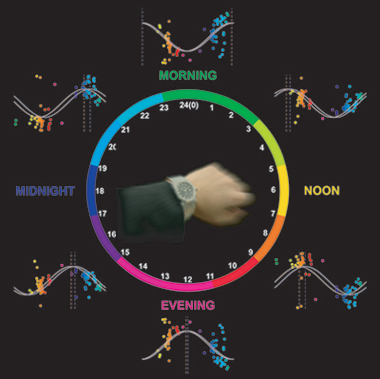| RIKEN Center for Developmental Biology (CDB) 2-2-3 Minatojima minamimachi, Chuo-ku, Kobe 650-0047, Japan |
June 8, 2009 – Our bodies, and those of all animals, have intrinsic mechanisms that ensure that their many internal systems, such as sleep and hormone secretion, follow closely to the rhythm of the earthly day. Many diseases, such as those of the heart and vasculature, also show changes in the severity of symptoms at different times of day, and disturbances of the circadian rhythm can create great difficulties for individuals in their waking and sleeping lives. A technique for measuring the body’s own time, would open the prospects of a new “chronotherapy” approach to medicine. But we have yet to decipher the code of the body’s clock. Now, a study by Yoichi Minami, Takeya Kasukawa and others inthe Laboratory for Systems Biology (Hiroki R. Ueda, Team Leader) working in collaboration with colleagues at Keio University (Tokyo, Japan) reveals a method for measuring bodily time by analyzing metabolic products in the blood. This new approach to reading circadian status is published in the Proceedings of the National Academy of Sciences USA.
The inspiration for the study actually came from an 18th century Swedish botanist named Karl von Linne, who discovered that one could estimate the time of day simply by watching which types of flowers had opened their blooms. Minami and Kasukawa thought that they might be able to do the same thing by looking at gene expression and metabolites, instead of flowers. The Ueda lab had made a first important step toward that goal by developing a molecular timetable for the mammalian biological clock in 2004, but the method involved analyzing gene expression in the liver, making it unfeasible for simple clinical uses. The team turned next to a metabolomics approach, which entails sampling a comprehensive set of metabolites in the bloodstream to get a snapshot of the body's state at any given time. However, such an approach had never been applied to substances with oscillating levels in the blood. Minami, Kasukawa and colleagues drew blood at 4-hour intervals from mice for two days and analyzed the samples using a combined liquid chromatography and mass spectrometry technique developed at Keio University. Mathematical analysis of the samples revealed a set of 142 positive ion and 176 negative ion metabolic products that showed clear rises and falls over the course of a 24-hour day. Importantly, mice with known circadian defects showed aberrant metabolic cycles as well. The team tested this newly developed metabolite timetable by sampling mice at arbitrary times of day, and comparing their results with the predictions from the new technique, and found that it provided an admirably accurate picture of the body’s circadian state. Additional tests using mice of different genetic backgrounds, genders, ages and feeding conditions further confirmed the general applicability of the method. They next entrained mice to an altered daily rhythm and looked at whether the timetable would hold up in these “jet-lagged” animals. They found that on the first day of jet-lag, the circadian metabolites remained at their previous levels, but by day 5, they were at an intermediate state between real time of day and the entrained time, and by day 14, the switchover to the new cycle as measured by metabolomics was complete. “People show much greater diversity than mice in their eating habits and daily schedules, so it would be important to take that into consideration in developing any clinical applications,” says Kasukawa. Minami also adds, “The technique will need to be simplified before it can enter widespread use. But I think this metabolite timetable represents a significant step forward in the drive to realizing chronotherapy.” |
|||||
|
|||||
 |
| Copyright (C) CENTER FOR DEVELOPMENTAL BIOLOGY All rights reserved. |
